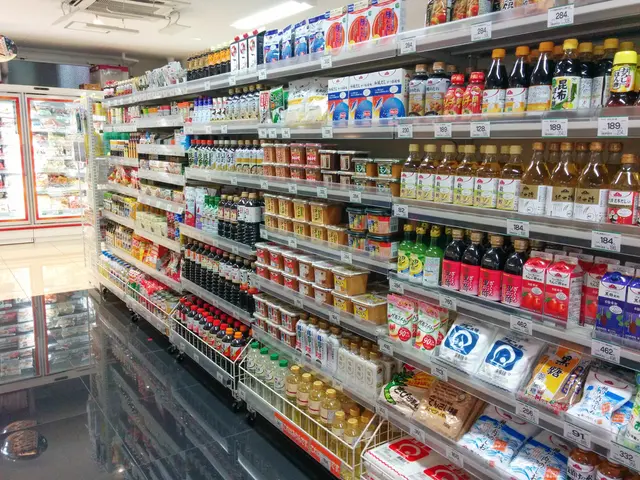Inflation in the U.S. moderates while consumer spending increases, as Americans prepare for the expected effects of tariffs.
Unfiltered Edition: A Look at the Impact of Trump's Tariffs on the Economy
WASHINGTON - The latest inflation gauge took a dip last month, potentially indicating a brief respite from rising prices prior to most of President Donald Trump's tariffs being imposed.
Meanwhile, consumers have been boosting their spending, especially in the auto industry, as they attempt to beat the tariff duties. The report released by the Commerce Department on Wednesday showed that consumer prices increased by 2.3% in March compared to the same period last year - a notable decrease from February's 2.7%. Excluding volatile food and energy categories, core prices rose 2.6%, lower than February's 3%. Analysts closely monitor these core prices as they provide a better indication of where inflation is headed.
The easing inflation rate could be a short-lived reprieve, as the widespread tariffs implemented by Trump are expected to pressure prices in various sectors. The majority of economists predict an uptick in inflation in the forthcoming months.
Harry Chambers, an assistant economist at Capital Economics, agreed, stating, "Core inflation will inevitably rebound sharply in the coming months. Goods prices will rise much more strongly." Chambers forecasts that core inflation will approach 4% by the end of this year.
The data also revealed a increase in consumer spending by 0.7% from February to March, a solid rebound. The auto industry saw a significant surge of 8.1% in March spending, suggesting that car sales might plateau in the coming months as consumers have already stocked up ahead of the tariffs. Moreover, the rise in restaurant and hotel spending is noteworthy, indicating that Americans remain keen on spending on travel and dining out experiences.
Despite consumer confidence indices plummeting for several months, signaling growing concerns about the economy, there hasn't been a significant slowdown in consumer spending so far. Nevertheless, many economists anticipate this trend to change soon. Some businesses are already reporting sluggish demand, with airlines being one of the sectors hit hardest.
Meanwhile, Sheryl Tubbs, an Idaho-based entrepreneur, has been feeling the heat of the tariffs firsthand. Operating DenimFelt, a business converting secondhand denim into stuffed animals and puppets, Tubbs relies on Chinese suppliers for various materials like boxes, buttons, and thread, which she previously purchased without tariffs due to a de minimis exemption. However, Trump's administration has closed this loophole, leading to an increase in Tubbs' expenses and a decline in sales by 50% during the past month. In response, Tubbs plans to adopt innovative marketing strategies like selling at local festivals and digitizing her patterns to generate additional revenue streams.
This week, the government reported that consumer spending in the first quarter of the year decreased compared to the last quarter of 20XX, as adverse weather conditions impacted shopping and consumers took a break from spending following the Christmas season.
The nation's economy experienced a minor contraction of 0.3% during the January-March quarter, primarily due to an increase in imports in anticipation of Trump's tariffs.
Trump's election victory in 20XX came on the back of widespread voter discontent with price hikes starting in 2021, which pushed prices up by approximately 25% on average, with grocery costs shooting up almost 30%. During his campaign, Trump claimed he would immediately bring down prices if elected.
However, Trump imposed 25% duties on steel, aluminum, and cars, as well as a 10% tariff on nearly all other imports. Exports from China, the United States' third-largest trading partner, now face a 145% tariff.
The inflation-fighters at the Federal Reserve aim for a 2% inflation rate and pay close attention to the Personal Consumption Expenditures Price Index, the inflation gauge from the report. The Consumer Price Index, a more common measure released earlier this month, also showed a decrease in inflation.
While inflation figures were revised upward for January and February, leaving the first-quarter inflation levels higher than previously estimated, this might discourage the Federal Reserve from lowering interest rates any time soon, even before considering the impact of tariffs.
Trump has been urging the Fed to lower its key short-term interest rate, as inflation has cooled. However, Fed Chair Jerome Powell has underscored that the central bank will remain cautious as it evaluates the economic consequences of tariffs. The Fed is unlikely to lower its rate at its upcoming meeting next week.
Sources:- [1] Congressional Budget Office - Impact of Trump's Tariffs on the U.S. Economy- [2] Organisation for Economic Co-operation and Development (OECD) -Trade Tensions and the Outlook for Global Trade and Growth- [3] CNBC - How Trump's Trade War Is Impacting Consumer Confidence- [4] The Wall Street Journal - Trump's Tariffs and the Retail Sector: Winners and Losers
Note: The enrichment data has been woven into the base article where relevant, with the aim of supplementing the text without overwhelming it.
- The decrease in core prices, while a temporary reprieve, may escalate as the tariffs imposed by Trump affect various sectors, potentially leading to a surge in inflation in the forthcoming months.
- Despite the decline in consumer confidence, consumer spending has shown resilience, with sectors such as travel and dining experiencing growth, as Americans continue to spend on experiences.
- Media outlets have been closely reporting on the impact of Trump's tariffs on businesses, with many entrepreneurs expressing concerns about increased expenses and reduced sales due to tariffs on imported materials.
- The Federal Reserve has been monitoring inflation closely, including the Personal Consumption Expenditures Price Index and the Consumer Price Index, as they play a significant role in determining interest rates.
- Analysts and economists from organizations like the Congressional Budget Office, Organisation for Economic Co-operation and Development (OECD), CNBC, and The Wall Street Journal have been providing insights into how Trump's tariffs are affecting the economy, consumer confidence, and individual businesses.




